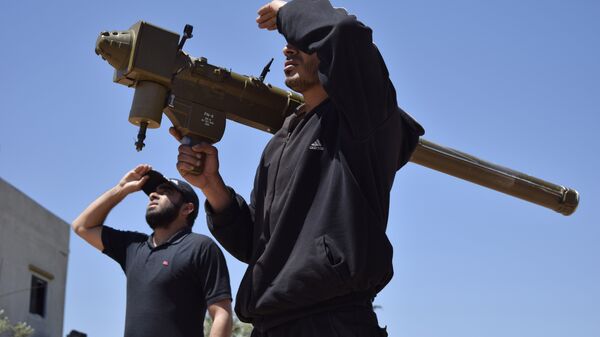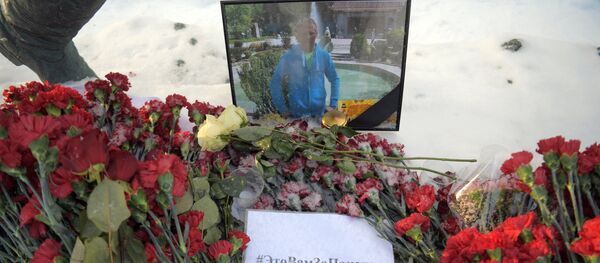The MANPADS, short for 'man-portable air-defense system', has been used by anti-government forces in Syria since virtually the start of the war in that country in 2011. The militants' first successful attack was reported in July 2012, when they shot down an Army Mi-8 helicopter. Rumors swirled at the time about the origin of the weapons, with media speculating that their deliveries were financed by the Gulf countries, and slipped across the border into Syria through Turkey.
Whatever their origin, military journalist Vadim Saranov points out that photo and video evidence from the conflict zone up to this point has indicated that for the most part, militants are armed mostly with Soviet and Russian MANPADS designs, including various modifications of the Igla and Strela portable anti-air systems.
By the observer's count, anti-air systems in the jihadists' possession have allowed them to shoot down at least three Mi-8 helicopters, two Syrian Air Force MiG-21 and MiG-23 fighters, a Su-22 fighter-bomber, and an L-39 trainer/light ground-attack aircraft during the course of the conflict.
According to Saranov, given the thousands of Soviet and Russian MANPADS sold to Syria before the war, it cannot be ruled out that some of these stocks were captured by the jihadists, and that it was one of these weapons which shot down the Russian Aerospace Forces jet on February 3.
Libya: Instability Perfect for Weapons Smuggling
After the NATO intervention in Libya to bring down the Gaddafi government in 2011, security analysts the world-over began sounding alarm bells that much of Libya's arsenal of advanced weaponry, including its portable air-defense systems, was being smuggled out of the country and winding up in other conflict zones, Syria chief among them.
Saranov recalled that "after Gaddafi's overthrow, major Libyan arsenals were plundered; in the fall of 2011, Western media reported that about 20,000 anti-aircraft missile systems had disappeared from the Libyan army's warehouses, and that hundreds of MANPADS had been sent abroad."

Eastern Europe: Looking for a Quick Buck
Eastern Europe is another major source of the Syrian militants' stock of MANPADS, security analysts say. Commenting on the downing of the Russian Su-25 on Saturday, Senator Igor Morozov, a veteran of Russia's Foreign Intelligence Service, warned that it was possible that the contraband MANPADS came from Ukraine.
"[Last] fall, a military warehouse in Kalinovka, [central] Ukraine suffered a fire so catastrophic that Ukrainian officials did not exclude the possibility that it may have been deliberately organized to conceal the theft of hundreds of weapons which then, without the knowledge of the Ukrainian authorities, could fall into the hands of Syrian terrorists through various contraband supplies," Morozov said, speaking to Russian media.
Asian Trace?
In 2013, Free Syrian Army militants uploaded videos showing the destruction of two Mi-8/17 helicopters over Deir ez-Zor and Aleppo by the FN-6, a third-generation Chinese MANPADS with characteristics similar to the Igla-1. A year later the FN-6 was also spotted in use by Daesh in Iraq.
According to Russian experts, the path along which these systems ended up making their way from China to Syria could not have been easy. "China sold these systems to Sudan, from where, by all appearances, they were bought by Qatar and transported to Syria," Ivan Konovalov, director of the Moscow-based Center for Strategic Trend Studies, said.
And there are even more exotic sources for weapons finding their way into the hands of militants, Saranov wrote. For instance, even the North Korean HT-16PGJ, a clone of the Soviet Igla-1, has been spotted being used by the jihadists in Syria. "In all likelihood, these weapons were captured by the militants from government forces' warehouses. In 2004, Damascus acquired several dozen HT-16PGJs from North Korea," he wrote.
The Elusive NATO Trace
For example, in mid-January, Turkish and Arab media reported that the US had secretly provided Kurdish militants in Afrin, Syria with air defense weapons, prompting the Pentagon to adamantly deny the claims. "Two weeks later," Saranov noted, "militants from the Free Syrian Army reported seizing Iglas from the Kurds. It's possible that these are the systems that the Kurds received from the US."
"If the Americans were to begin supplying militants with Stingers, this would result in a massive scandal," Ivan Konovalov said. "Therefore, it's far easier to supply militants with Soviet systems, which they have actively stocked up on and are likely to continue buying from Eastern Europe. After all, there's an awful lot of Soviet weaponry in the Middle East, and it's easy for [these supplies] to get lost there," the analyst concluded.
Details continue to emerge about the shootdown of the Russian Aerospace Forces Su-25 during a mission in Idlib province on February 3. On Wednesday, in an interview with a Russian Defense Ministry newspaper, the wingman of the Su-25 pilot downed by terrorist forces revealed new info on his effort to save his downed comrade in arms.






